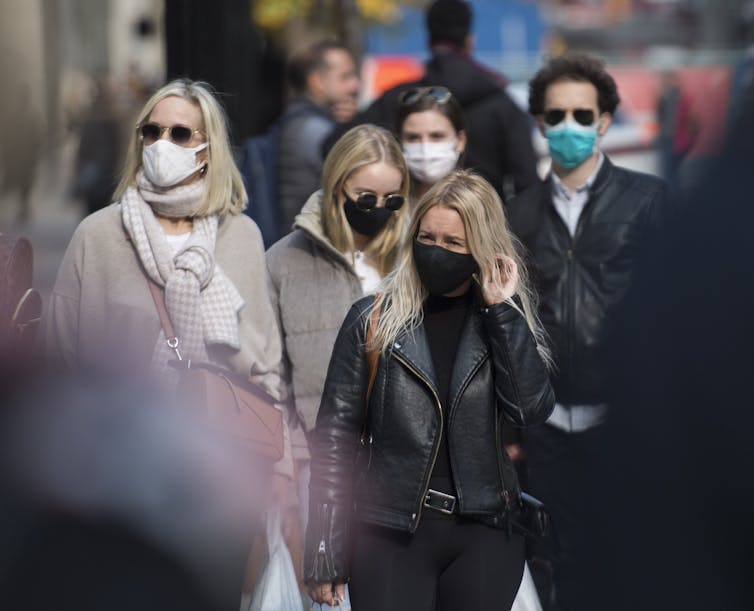
Stephen Archer, Queen's University, Ontario
Good science and sound public health policy are needed to guide us through a pandemic that will likely continue throughout 2021. Public buy-in is essential for long-term adherence to effective public health measures such as wearing masks in indoor spaces, hand washing, maintaining physical distancing and staying home when sick.
These measures can control case spread but, let’s face it, they are no fun. Even harder to weather are the intermittent closures of businesses and schools in response to local pandemic spikes.
We have never been in more need of coherent and consistent messaging from the medical professionals, scientists, public health agencies and the government. Unfortunately, reckless messaging by some doctors and scientists is feeding mistrust of public health policies.
Infectious bad ideas called cognogens readily spread in our stressed pandemic environment. One such cognogen, the Great Barrington Declaration , is causing harm. The declaration takes its name from Great Barrington, a Massachusetts resort town. This declaration, signed by 12,000 people, is sponsored by the American Institute for Economic Research, a libertarian think-tank.
The declaration begins with the false premise that governments intend to lock down society, and cherry-picks facts (for example, that COVID-19 infections are mild in healthy people). It states:
“Those who are not vulnerable should immediately be allowed to resume life as normal. The most compassionate approach that balances the risks and benefits of reaching herd immunity, is to allow those who are at minimal risk of death to live their lives normally to build up immunity to the virus through natural infection, while better protecting those who are at highest risk.”
The 5 flaws
1. It creates a false dichotomy. The declaration rhetoric offers a false choice between a wholesale return to our pre-pandemic lives (which is objectively dangerous) versus a total lockdown (which no one advocates). Across Canada, schools, daycares and businesses are open and we are providing health care for patients who suffer from non-COVID-19 diseases. Timothy Caulfield, Canada Research Chair in health law and policy, notes that it’s not a binary choice between the Barrington perspective and full lockdown, and that governments are striving to balance public health with economic recovery.
This is true in Ontario where, after the first COVID-19 peak, the province reopened in three stages, guided by epidemiology.
2. The Barrington declaration gives oxygen to fringe groups. The signatories did not intend to support such fringe groups, but their rhetoric invalidates public health policy and feeds the 19 per cent of North Americans who don’t trust public health officials.
When physicians and scientists sign on to the declaration they support the fears of an increasingly anxious public and fuel conspiracy theories. This is even more dangerous in America with a president that many people view as divisive, and fringe groups such as the paramilitary Oath Keepers and QAnon.

3. The Barrington declaration puts individual preference far above public good. The declaration advocates that, “individual people, based upon their own perception of their risk of dying from COVID-19 and other personal circumstances, personally choose the risks, activities and restrictions they prefer.”
If these views were applied to traffic safety, chaos would ensue as we each chose our own speed limit and which side of the road to drive on. Public health matters, and the approach of the declaration to place ideology over facts helps fuel the pandemic.
4. The declaration misunderstands herd immunity. Herd immunity occurs when a large enough proportion of the population has immunity, usually more than 70 per cent. Viral spread is then slowed because the virus largely encounters immune people. Herd immunity can be safely achieved by vaccines, but in order to “naturally” develop herd immunity, people must first survive the infection.
Despite more than nine million cases in the United States, less than 10 per cent of Americans have COVID-19 antibodies. Even if true caseloads were 10-fold greater than recognized, 94 per cent of people remain susceptible and, if rapidly infected, would swamp the health-care system and lead to many avoidable deaths.
The declaration’s approach amounts to a global chickenpox party, a historical means of generating immunity to the varicella-zoster virus that causes chickenpox. Healthy children were put in close contact with an infected child so that all became infected with chickenpox.
Unfortunately, even some healthy children suffered severe complications and unintended people were often infected. At least with chickenpox there was no risk of epidemic spread because society had herd immunity (which we lack for COVID-19).
5. The declaration offers no details on how it would protect the vulnerable. In Ontario, more than 60 per cent of COVID-19 deaths have occurred in residents of nursing homes and long-term care (LTC) facilities. COVID-19 is imported into LTCs from the community by relatives and health-care workers, so we must prevent viral spread in the community to keep these vulnerable people safe.
The experts have spoken: Experts view the Barrington declaration as wrong-minded and dangerous. Dr. Anthony Fauci dismissed the idea, calling it dangerous.
The declaration is also rebutted by the 6,400 vetted signatories of the John Snow Memorandum, named for the 19th-century pioneer of epidemiology.
The Snow memorandum cites clear evidence that the virus is highly contagious, several times more lethal than influenza and can have lasting consequences, even in healthy people. It affirms that COVID-19 can be constrained by good public health measures, and warns that herd immunity may be hard to achieve. It concludes:
“… controlling community spread of COVID-19 is the best way to protect our societies and economies until safe and effective vaccines and therapeutics arrive within the coming months.”
The Infectious Diseases Society of America’s 12,000 front-line infectious diseases scientists, physicians and public health experts strongly denounce the Barrington declaration.

Finally, Wisconsin’s epidemic exemplifies the failure of Barrington declaration’s ideology. Its Republican-controlled legislature has supported legal challenges to the governor’s mask mandate even as the state’s rate of positive COVID-19 tests spiked to nearly 30 per cent and hospitalizations skyrocketed.
The Great Barrington Declaration, supported by U.S. President Donald Trump, is naive and dangerous. Physicians and scientists must be responsible in our pronouncements and not sow mistrust of effective public health measures.
Stephen Archer, Professor, Head of Department of Medicine, Queen's University, Ontario
This article is republished from The Conversation under a Creative Commons license. Read the original article.

